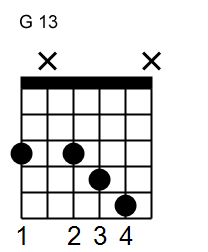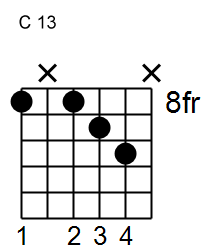At a certain point, you want to expand beyond the standard guitar chords such as C, D, E minor and the like. You may get out on the web and read about chords that have letter names with numbers after them, like G 13, C 9, or A augmented. I’m referring to these chords as “exotic” and penned this blog post to give a brief introduction to them, one that is not bogged down with music theory. For each chord I will provide some chord daigrams and explore a few situations where it can be used. You can then quickly apply that knowledge to your own songwriting and playing.
A couple points of note: If you’ve never played these chords shapes before it can take a some time to get your fingers wrapped around them. Much of the advice I offered in the following post can be applied to these exotic chords: Learning chord shapes on the guitar.
Also, for this post I am presuming you are familiar with the standard major, minor and 7th chords including, ideally, barre chords. If you are not, you can still get some valuable information from this post though there may be some points of confusion.
A word about diagrams
For all the chords discussed I will be showing moveable chord shapes. These are shapes that can be moved around the fretboard to form different instances of a type of chord. For instance, this is a 13th chord with a root note of G known as G 13.

This is a 13th chord with a root note of C known as C13.

As you can see, it’s the same shape, just moved up the neck. For all the chords I demonstrate, the root note of the chord (for example, the C note in a C13 chord) will be the lowest note in the shape, found on the 6th or 5th string. To play specific chords you will need to move the chord shape to the correct position. If you need help finding the notes on the guitar, see this diagram.
Let’s explore some chords!
Diminished chords
These chords are often written as dim (e.g “E dim”).
Diminished chords are strange little beasts with a dissonant quality. They can be found frequently in classical music and early jazz and ragtime. They are less common but not unheard of in rock and pop.
Diminished chords often lead into other chords, usually by approaching a chord from a half step below it. Try this classical sounding progression:
| C min D dim | Eb B dim | C min |
Note how the diminished chords are a half step below the chord that follows them.
You can get a slightly jazzier sound when moving from diminished chords into a standard 7th chord. First, play through the following progression:
| G | D7 |
Now let’s add in a diminished chord right before that D7 chord
| G C# dim| D7 |
A ragtime sounding trick is to move from a chord to a diminished chord with the same root and back to the original. For example:
| G G dim | G |
One final point about diminished chords: If you play a diminished chord and then play the same shape three frets up, you are playing an inversion of the chord. These means both chords have the same notes, the notes are merely stacked in a different order. So you often hear chords progressions like this:
| C | B dim D dim | F dim G# dim | C |
All those diminished chords have the same notes, so one can be substituted for another.
___________
Augmented chords
These chords are often written with a plus sign (e.g “E+”).
Like the diminished chord, the augmented chord has a somewhat sour flavor but when used in the right context it can create very interesting sounds.
Augmented chords tend to point to (or “resolve” to) chords with roots that are a 4th interval away. (Sorry, had to slip a little music theory in there. Here’s a quick way to identify chords a 4th away. Start with a chord with its root note on the 6th string. Move your finger from this 6th string root note to the note on the same fret on the 5th string. A chord built of that new note would be a 4th away from the original note. For example, a C chord (which has a root on the third fret/fifth string) is a 4th away from a G chord. So a G augmented chord would resolve to a C chord (major or minor.))
Let’s look at some example progressions.
| C G+ | C |
| A min E+ | A min |
| D min A+ | D min |
Here’s a more complex one.
| G F#+ | Bmin E7 | A min D+ | G |
Standard 7th chords often transition to augmented chords with the same root. Let’s consider this common chord progression.
| C | G7 | C |
Now try this:
| C | G7 G+ | C |
I also think augmented chords sound nice when used a half step below a minor chord. For example, try the following progression using chords with 6th string roots.
| A min G#+ | F E7 |
It has a creepy, Tom Waits sound to my ears.
___________
Minor/major 7th chords
This chord is famously used in many songs as a way of transitioning between a minor chord and a minor 7th chord with the same root. For example:
| Dmin D min/maj7 | D min7 G |
Or:
| A min A min/maj7 | A min7 D |
___________
Major 9th and 13th chords
I group these two types of chords together because we are going to explore them in similar contexts.
You may be familiar with a standard 12 bar blues pattern, very popular in blues (obviously) and rock music. Here it is in the key of A.
| A7 | A7 | A7 | A7 | | D7 | D7 | A7 | A7 | | E7 | D7 | A7 | A7 |
Now any one of those 7th chords can be replaced with a 9th or 13th chord. So we could rewrite the 12 bar progression above as:
| A13 | A13 | A13 | A13 | | D9 | D9 | A13 | A13 | | E9 | D9 | A9 | A9 |
9th and 13th chords are also great for funky vamps. Vamps are sections of music where we just play one chord for a while. You can get a James Brown vibe by applying some funky strumming one of these chords like:
| E9 | E9 | E9 | E9 |
You could also jazz up the progression by going back and forth between 9ths and 13th chords, like:
| E9 | E13 | E9 | E13 |
It’s also common in such situations to quickly approach a vamped chord from a half step below, usually on beat “4” or “4 and” of the preceding bar.
| E9 D#13| E13 D#9| E9 D#13| E13 |
___________
Flat 9 chords
These chords are often written as b9 (e.g “E b9”).
This chord can work well with minor chords, often providing a spooky or melancholy flavor. Like augmented chords, flat 9 chords tend to point to (or “resolve” to) chords with roots that are a 4th interval away. Here’s some example progressions.
| C min | G b9 | C |
(The G b9 points to the C chord.)
| C | A b9 | D min | G b9 | C |
(The A b9 points to the D min chord.)
Something to keep in mind with flat 9 chords: they can often be replaced with a diminished chord that has a root note a half step higher than the flat 9 chord’s root note. This means that:
G b9 can be replaced with G# dim…
B b9 can be replaced with C dim…
D b9 can be replaced with D dim…
And on and on. Try replacing the flat 9s in the progression above with diminished chords and see how they sound.
Minor 9 chords
This chord has a variety of uses but I mainly associate it with soul/RnB ballads. And Pink Floyd dirges.
When you are playing a chord progression in a minor key, the chord built off the root note of the key can always be replaced with a minor 9 chord. So, in the key of E minor, an E min chord can be replaced with a E min 9 chord, like so:
| E min | A min | C | B7 |
can become…
| E min9 | A min | C | B7 |
In that above progression, the A min chord could also be replaced with a min9 version, so:
| E min9 | A min9 | C | B7 |
Let’s consider this chord’s uses if you are in major key. Every major key has a root chord of course – in C major that chord would be a C chord. Find a C note and move two frets over and you have a D note. The min9 chord built off that root will sound good; this would be a D min9. So would the min9 chord built of the note that is three frets down from C, an A note, resulting in an A min9 chord. Here’s a sample major key chord progression using these chords.
| C A min9 | D min9 G |
Min 9 chords are also good for funky vamps, just like maj 9th and 13 chords. You can even “approach them” from down a half step on beats “4” or “4 and”.
| E min9 D#min9 | E min9 D#min9 |
___________
That’s it for now. Would you like a similar introduction to other exotic chords? Drop me a comment below.














Nice! I like the way you laid out this post, skipped all the scary theory and got right to how to use the chords in real situations.
Thanks M.J. I went to your web site and realized I bought and read your book “Grow Teach Repeat” a few years ago!
Awesome! Hope you liked it. I am currently updating all my stuff. After all these years, I still find mistakes! Proofreading is hard.